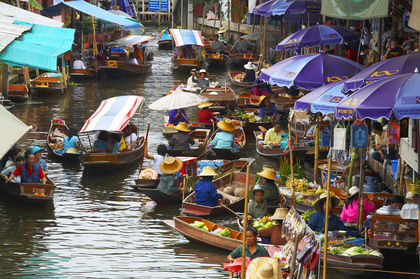Thailand - International trade

Thailand has a long history of international trade. Beginning in the 15th to 18th centuries, during the reign of the Ayutthaya monarchy, foreign merchants who lived near the kingdom's capital conducted trade with foreigners. The country's first significant trade treaty was
| Trade (expressed in billions of US$): Thailand | ||
| Exports | Imports | |
| 1975 | 2.208 | 3.280 |
| 1980 | 6.505 | 9.214 |
| 1985 | 7.121 | 9.242 |
| 1990 | 23.070 | 33.379 |
| 1995 | 56.439 | 70.776 |
| 1998 | 54.456 | 42.971 |
| SOURCE: International Monetary Fund. International Financial Statistics Yearbook 1999. | ||
the Bowring Treaty in 1855 with Britain. Shortly after that, it also signed treaties with 14 other countries including the United States, France, Russia, Sweden, Spain, and Japan.
Today, the United States, Japan, and the European Union continue to be its top trading partners, absorbing 52.6 percent of all exports in 1999 and supplying 48.8 percent of total imports in the same period. Its other partners are Hong Kong, China, and the Association of South-East Asian Nations (ASEAN) countries, the most significant of which are Singapore and Malaysia. Other countries apart from those mentioned accounted for 18.4 percent of exports and 21.6 percent of imports in the same period.
Thailand's major exports are rice, tapioca products, cane sugar and molasses, and rubber for agriculture; chemicals, polymers, and plastics for the manufacturing industry; and gypsum, natural gas, and feldspar for the mining industry. Bank of Thailand statistics as reflected in the Asian Economic Survey of 2000 identified the country's major export products as machine parts, circuits, frozen shrimp, prawns, sundry items, computer parts, garments, vehicle parts, and plastic products. On the other hand, its major imports are petroleum, integrated circuit parts, and chemicals.
The balance of trade was consistently negative until 1998, which means that the value of the country's imports was bigger than the value of its exports. The discrepancy was minimal in 1970, with import value exceeding export value by only US$541 million. In 1975, imports exceeded exports by US$1.072 billion, which doubled in 1980 to US$2.709 billion. In 1985, imports still exceeded exports by US$2.21 billion, which had quadrupled by 1990 to US$10.309 billion. In 1995, the balance still stood in favor of imports by US$14.337 billion. In a considerable reversal, imports in 1997 exceeded exports by US$5.319 billion but the following year, exports exceeded imports by US$11.485 billion.
Despite the uneven balance of trade, the Thai economy continued to grow by an average of 6.8 percent in the 1970s, 7.5 percent in the 1980s, and 8 percent in the early 1990s before the Asian financial crisis. This growth can be attributed to 2 factors, namely the boom of the tourism industry and the inflow of foreign direct investment. According to International Historical Statistics, in 1970, the services sector contributed 44.1 percent of GDP, which increased in 1980 to 49.7 percent. Though this contribution fell to 46.9 percent in 1999, it is safe to say that the dollar earnings from the tourism industry generated a substantial amount, enough to offset the trade imbalance.
Foreign direct investment (FDI) is another major factor in the growth of the economy since the mid-1980s. In 1988, FDI infused US$1.25 billion into the economy, partly explaining the 7.5 percent growth despite a US$4.332 billion discrepancy in balance of trade in favor of imports. Foreign direct investment doubled to US$2.5 billion in 1990.
Thailand is a member of several international trade organizations including the ASEAN Free Trade Area (AFTA), the Asia Pacific Economic Cooperation (APEC), and the World Trade Organization (WTO).
Comment about this article, ask questions, or add new information about this topic: